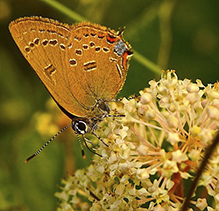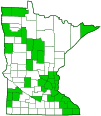Edwards’ hairstreak
(Satyrium edwardsii)
Conservation • Description • Habitat • Ecology • Distribution • Taxonomy
|
|
||||||||||||||
Description |
Edwards’ hairstreak is a small to medium-sized, gossamer-winged butterfly. It occurs in the United States east of the Great Plains and in adjacent Canadian provinces. It is found from late June to early August in open oak woodlands and woodland edges, and in oak savannas. It is locally common and sometimes abundant in Minnesota. Adults have a ¾″ to 1½″ (19 to 38 mm) wingspan. The upperside of both wings is dark brown. The hindwing has two hair-like tails near the tip, one long and one short. There is sometimes an orange spot above the tails. However, this butterfly perches with wings closed and is rarely seen from above. The underside of both wings is brownish-gray with a thin black margin on the trailing edge. On the forewing there is a row of narrow submarginal spots and a row of larger postmedial spots. The submarginal spots are outlined with white just on the inside. The postmedial spots are rectangular and distinctly separated. They are outlined in white, boldly on the outside, narrowly on the inside. There is also a well-defined, longer, horizontal, medial stripe outlined in white. The hindwing is similarly marked but the submarginal spots are distinctly crescent-shaped. There is a large, light blue spot below the tail and a long, narrow, orange spot on the inner margin at the anal angle. The blue spot is not topped with orange. The marginal spot immediately above the tail has a prominent orange cap. The next three spots have smaller orange caps gradually decreasing in size and fading. The eyes are black. The antennae are striped black-and-white and have an orange-tipped club. The caterpillar is wide, somewhat flattened, dirty brown, and short, no more than 1″ long. The breathing pores (spiracles) are pale but not prominent. On each side there is a stripe near the middle (subdorsal stripe) and a less prominent stripe below the spiracles (subspiracular stripe). The area between the subdorsal stripes is darker brown. On each abdominal segment there is a single, blurry, oblique line between the subdorsal and subspiracular stripes. |
Size |
Wingspan: ¾″ to 1½″ (19 to 38 mm) |
Similar Species |
Habitat |
Open oak woodlands and woodland edges; oak savannas |
Ecology |
Season |
One generation per year: Late June to early August |
Behavior |
The adult feeds at night. It perches with closed wings usually about three feet off the ground or high in trees. It is rarely seen with spread wings. The caterpillar feeds during the day. At night it hides in an ant nest at the base of a tree. |
Life Cycle |
|
Larva Hosts |
Leaves of pin oak, red oak, black oak, bur oak, and white oak. |
Adult Food |
Flower nectar |
Distribution |
||
|
Sources 21, 24, 27, 29, 30, 71, 75, 82, 83. Biodiversity occurrence data published by: Minnesota Biodiversity Atlas (accessed through the Minnesota Biodiversity Atlas Portal, bellatlas.umn.edu, 7/11/2025). |
|
| 7/11/2025 | ||
Occurrence |
||
Locally common to abundant |
||
Taxonomy |
|
Order |
|
Superfamily |
Papilionoidea (Butterflies) |
Family |
Lycaenidae (Gossamer-winged Butterflies) |
Subfamily |
Theclinae (Hairstreaks) |
Tribe |
Eumaeini |
Subtribe |
Callophryidina |
Genus |
Satyrium |
Subgenus |
Satyrium |
Subordinate Taxa |
|
Edwards’ hairstreak (Satyrium edwardsii edwardsii) Edwards’ hairstreak (Satyrium edwardsii meridionale) |
|
Synonyms |
|
Thecla edwardsii Thecla fabricii |
|
Common Names |
|
Edwards’ hairstreak |
|
Glossary
Anal angle
In insects: The angle at the corner of a wing formed where the outer and inner margins meet.
Spiracle
A small opening on the surface of an insect or arachnid through which it breathes.
Visitor Photos |
||
Share your photo of this insect. |
||
This button not working for you? |
||
Scott Leddy |
 |
Edwards’ hairstreak on New Jersey tea |
MinnesotaSeasons.com Photos |
||
|
||
|
||

Slideshows |
|

Visitor Videos |
||
Share your video of this insect. |
||
This button not working for you? |
||
|
Other Videos |
||
Edwards' Hairstreak Male |
About
Jun 28, 2015 This male Edwards' Hairstreak butterfly is guarding a breeding territory that it defends against other males. As a rival male approaches, the male takes off to give chase. |
Edward's Hairstreak nectaring at scrub oak gall |
About
Jan 22, 2014 June 25, 2013: An Edward's Hairstreak (Satyrium edwardsii) "nectaring" at a gall on a scrub oak bud. Sugars secreted by this bud may be the result of a cynipid wasp infection. |

Created: 3/26/2020 Last Updated: © MinnesotaSeasons.com. All rights reserved. |


